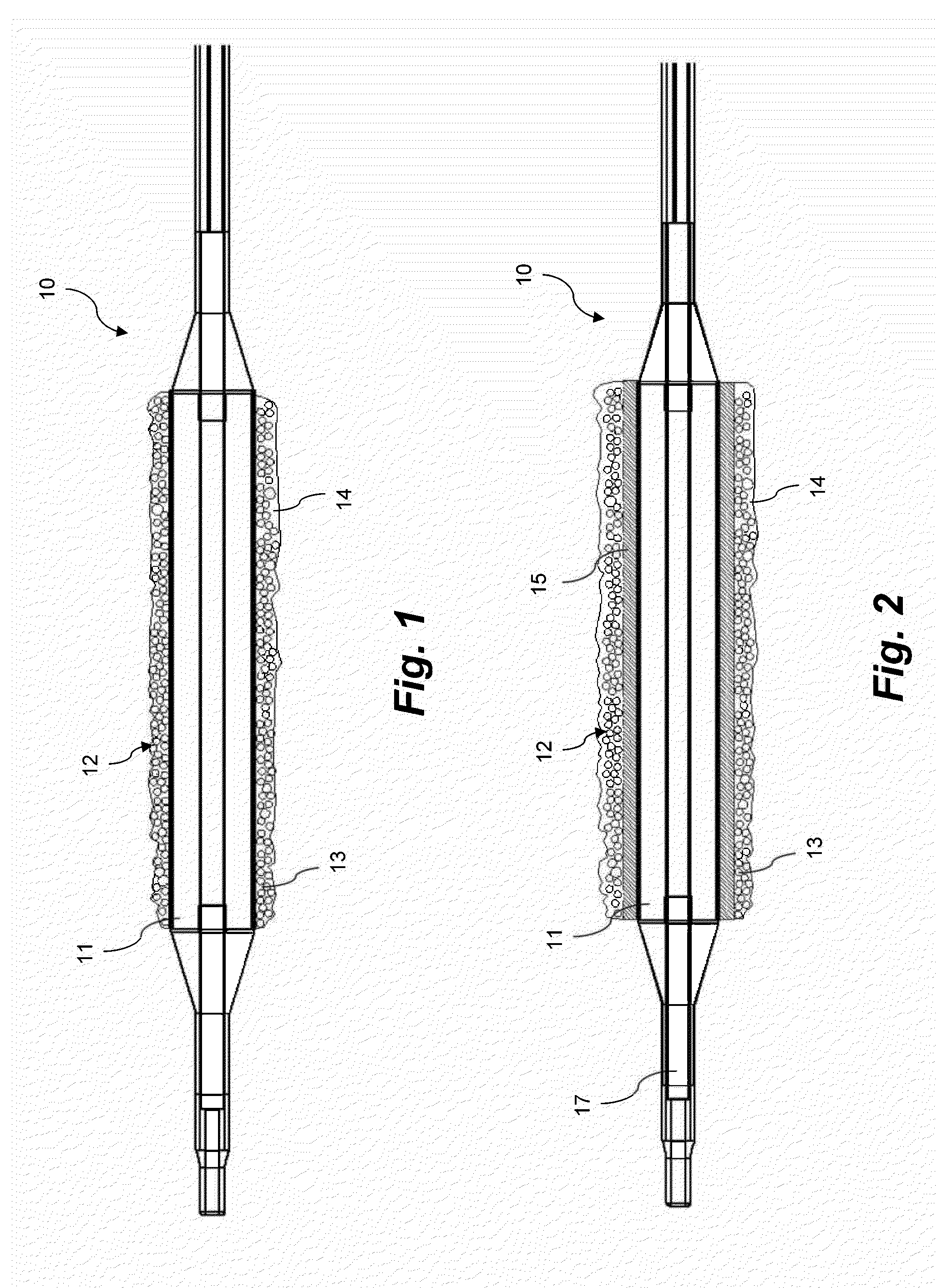Coating for intraluminal expandable catheter providing contact transfer of drug micro-reservoirs
a technology of expandable catheters and micro-reservoirs, which is applied in the direction of catheters, drug compositions, biocides, etc., can solve the problems of endothelial disruption, vessel tunica media dissection, and vessel injury to the vessel
- Summary
- Abstract
- Description
- Claims
- Application Information
AI Technical Summary
Benefits of technology
Problems solved by technology
Method used
Image
Examples
example 1
[0057]Drug Containing Micro-Reservoirs (Microspheres) spheres) fabricated by coacervation of polylactic-co-glycolic acid copolymer incorporating sirolimus (rapamycin) were obtained.
[0058]Microsphere sample 1: 50% DL-lactide / 50% glycolide copolymer, average diameter 3.1 μm, SD 0.44 μm, 39% rapamycin by weight
[0059]Microsphere sample 2: 75% DL-lactide / 25% glycolide copolymer, average diameter 3.2 μm, SD 0.76 μm, 40% rapamycin by weight
[0060]Microsphere sample 3: 50% DL-lactide / 50% glycolide copolymer, average diameter 2.7 μm, SD 0.8 μm, 45% rapamycin by weight
[0061]Microsphere sample 4: 75% DL-lactide / 25% glycolide copolymer, average diameter 3.3 μm, SD 1.2 μm, 46% rapamycin by weight
[0062]Microsphere sample 5: 75% DL-lactide / 25% glycolide copolymer, average diameter 4.1 μm, SD 0.61 μm, 25% rapamycin by weight
[0063]Microsphere sample 6: 75% DL-lactide / 25% glycolide copolymer, average diameter 3.78 μm, SD 0.44 μm, 28.8% rapamycin by weight
[0064]Microsphere sample 7: 75% DL-lactide / 25% ...
example 2
Sustained Drug Release from Micro-Reservoirs under Physiological Conditions
[0067]Micro-reservoirs from Example 1 were tested for sustained release of drug. Micro-reservoir samples of 2 to 5 mg weight were placed in 1.6 ml Eppendorf tubes with 1.2 ml of phosphate buffered saline (PBS) to simulate a physiological environment. After an initial wash to remove any drug not incorporated in the micro-reservoirs, the tubes were incubated at 37° C. with gentle mixing at 250 rpm. The PBS was sampled at time intervals and the released drug quantitated by reverse phase HPLC using a C18 column.
[0068]Micro-reservoirs were assayed for drug elution over 5 hours. The resultant drug release was fit to the Korsmeyer-Peppas kinetic equation for drug release from a polymer with dispersed drug. The results of the Korsmeyer-Peppas model are listed in Table 1.
TABLE 1Korsmeyer-Peppas Modeling of 5 Hour Drug ReleaseMicrosphereMicrosphereMicrosphereMicrosphereQ = a * x{circumflex over ( )}b1234R (correlation0...
example 3
Formulations of Micro-Reservoirs in Coating Formulation of Cholesterol and Fatty Acid with PEG-Lipid
[0076]A coating formulation was prepared with 107 mg of stearic acid, 105 mg of cholesterol, and 50 mg of DPPE-mPEG350 mixed with 14 mL of heptane and heated to 60° C. such that a clear solution was obtained. The solution was then vortex mixed for 30 seconds and allowed to cool. Next, 200 mg of sirolimus loaded microspheres of sample #6 was added, and the formulation was placed in an ultrasonic bath for 4 minutes to disperse and suspend the microspheres. [Formulation 1023E]
[0077]A coating formulation was prepared with 58 mg of erucic acid, 43 mg of DC-Cholesterol, and 6.25 mg of DOPE-mPEG350 mixed with 7 mL of heptane and heated to 60° C. such that a clear solution was obtained. The solution was then vortex mixed for 30 seconds and allowed to cool. Next, 100 mg of sirolimus loaded microspheres of sample #8 was added, and the formulation was placed in an ultrasonic bath for 5 minutes t...
PUM
| Property | Measurement | Unit |
|---|---|---|
| Fraction | aaaaa | aaaaa |
| Fraction | aaaaa | aaaaa |
| Fraction | aaaaa | aaaaa |
Abstract
Description
Claims
Application Information
 Login to View More
Login to View More - R&D
- Intellectual Property
- Life Sciences
- Materials
- Tech Scout
- Unparalleled Data Quality
- Higher Quality Content
- 60% Fewer Hallucinations
Browse by: Latest US Patents, China's latest patents, Technical Efficacy Thesaurus, Application Domain, Technology Topic, Popular Technical Reports.
© 2025 PatSnap. All rights reserved.Legal|Privacy policy|Modern Slavery Act Transparency Statement|Sitemap|About US| Contact US: help@patsnap.com



